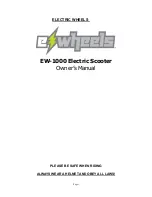
Page 56 of 106
Basic Rider Optimization Training for the Segway
HT
Instructor Guide and Participant Workbook
Rev 3.5i - January 2004
© Segway LLC 2002
P/N 1707100001aa
Guide
each participant to step off her Segway HT, enter Power Assist Mode, tilt the Platform
backward, and place a foot on the Mat. The Segway HT will give the Stick Shake Warning.
Participants have the opportunity to experience this warning in a controlled setting.
Forward versus Backward:
Having Speed Limiter move the bar forward cannot regulate backward speed. Since it is possible that
the rider continues to ride backwards at excessive speed, there is no way to enforce a backward
speed limit. In this case, the approach is to give a Stick Shake Warning above a certain speed to
deter
this kind of operation.
Stationary versus Moving:
In cases where the HT is stationary, it is still possible to demand more torque than the Segway HT
can produce. In this case, the Segway HT will stick shake to warn the operator it is at its limit. Some
low speed cases where the operator may experience a Stick Shake Warning due to exceeding torque
capabilities include:
>
Attempting to ride on/up a terrain which demands too much torque like a steep hill
>
Stopping too abruptly
Note
: During a hard stop, the torque capabilities of the left and right side may not be perfectly
matched – this can cause the Segway HT to rotate under a maximum-torque stop.
Appropriate Rider Response:
If you feel the Stick Shake Warning while riding, slow down. If the Stick Shake Warning persists,
come to a stop and safely step off.
Rider Detection
The Segway HT Platform contains four Rider Detect sensors (beneath the Mat), which detect the
presence or absence of a rider while the Segway HT is powered on. When a rider (weighing 100 lbs. /
45 kg or more) is aboard with feet properly positioned on the Platform, these Rider Detect sensors
are depressed, and allow the Segway HT to operate normally in Balance Mode. If fewer than three
Rider Detect sensors are depressed while riding, the Segway HT will reduce the top speed limit while
moving forward, regardless of the Key used. If the Segway HT is in Balance Mode, but none of the
Rider Detect sensors are depressed, and the Segway HT is moved too quickly, the Segway HT will
give the Stick Shake Warning after moving some distance, and will switch to Power Assist Mode. This
is intended to prevent a riderless Segway HT from traveling on its own. You should never let go of
your Segway HT while it is in Balance Mode.
You should never place anything on the Platform. Doing so could defeat this safety feature and allow
the Segway HT to travel on its own, and run into a person or property and cause injury or damage.
With an i or p Series model, you
can
move a riderless Segway HT in Balance Mode an indefinite
distance. To avoid getting the Stick Shake Warning, the Segway HT must be moved VERY slowly. If
you move the Segway HT slowly enough, the system is able to assess that even though the Segway
HT is moving in Balance Mode with no rider aboard, it is being controlled. Thus, no warning is
triggered. This function makes it easier for some people to pull the Segway HT upstairs, or guide it
down. Practice this technique on stairs with the participants, to show the possibility of the wheels
losing traction and spinning.
















































